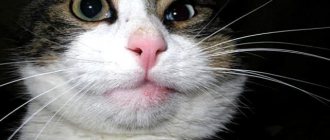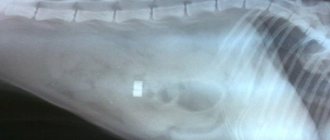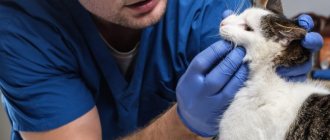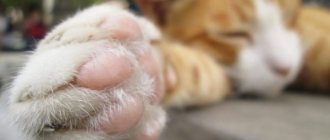The consequences of a wasp sting for kittens and allergy-prone pets can be tragic, even fatal. Therefore, in such a situation, you need to provide first aid to the animal as soon as possible. In addition, in some cases you cannot do without a veterinarian.
Let's find out what parts of a cat's body bites can lead to death and what needs to be done to save the pet.
Why is insect venom dangerous?
When a wasp bites, it inserts its sting into the skin and releases poison, which includes biologically active substances and enzymes. If they enter the bloodstream, they can cause serious health problems:
- Melitin. A toxin that destroys red blood cells, disrupts local metabolism in tissues, makes the walls of blood vessels permeable and contributes to the development of the inflammatory process.
- Histamine. It is a mediator of allergic reactions. It tones smooth muscles, expands capillaries and promotes the permeability of their walls, causing tissue swelling. Histamine also lowers blood pressure.
- Hyaluronidase. This is an enzyme that breaks down mucopolysaccharides and increases tissue permeability, which contributes to the spread of edema.
A bee or wasp sting can cause an allergic reaction, followed by intoxication of the body, and then anaphylactic shock.
A wasp sting is especially dangerous, since the venom of this insect is more toxic than that of a bee. When it gets into the skin it causes a strong burning sensation. The pain syndrome persists for several hours. However, this is not the main danger.
A Hymenoptera bite to the head or neck area is fraught with swelling, which can spread to the respiratory system and cause an attack of suffocation. No less dangerous is poison getting into the groin. In this case, swelling will obstruct the flow of urine. A bite to the eyelid can cause severe inflammation of the eye and can even lead to loss of vision.
When do you urgently need specialist help?
Such cases include situations when:
- The sting of an angry wasp hit your pet's head or throat. The appearance of edema in this case threatens to block the airways and can lead to suffocation.
- The eye is damaged, which is fraught with suppuration, the development of an inflammatory process with subsequent complications.
- A very small kitten suffered from a bite. The smaller the animal, the stronger the effect of the poison on its body and the result can be serious intoxication.
- The animal is highly sensitive to substances contained in insect venom.
But still, bites on the neck remain the most dangerous. And if this happens to your beloved kitten, then take him to the vet immediately.
Swelling in the airway area is dangerous because it can cause suffocation
And remember that the most vulnerable to poison are:
- Muzzle
- Language
- Neck
- Eyes
- Groin.
If the animal is stung in one of the listed places, then you need to quickly seek help from the clinic. After all, severe swelling in the neck will make breathing difficult and can lead to suffocation.
Damage to the eye can lead to blindness, and swelling in the groin can compress the urinary ducts. And if measures are not taken in time, this will lead to unpleasant consequences.
Cats of long-haired breeds are prone to allergies: Persians, British, Angoras. In addition, their bite is not immediately noticeable.
How to tell if a cat has been bitten by a wasp
Due to the thick fur, a wasp bite on a cat’s body is quite difficult to detect. If the owner was nearby during the insect attack, he will notice the pet's strange behavior. The cat will jump sharply to the side due to severe pain, begin to meow loudly and behave aggressively - hissing, scratching or biting.
Lameness is a sign that the sting has gotten into the paw. If a wasp stings a cat in the face, redness and swelling will appear almost immediately. In any case, cats that have been bitten do not behave as usual. The animal does not allow itself to be examined, it breaks out and licks the sore spot if it can reach it.
First reaction
First, redness appears at the site of the wasp or bee sting. The pet experiences itching and pain, like after a burn. Swelling gradually appears at the site of the bite. Sometimes it is small and resembles a lump the size of a nut. In some cases, the surrounding tissues greatly increase in size.
The stung animal tries to scratch, lick or even chew the affected area. To relieve pain, the cat presses against a cool surface - the ground, the floor.
Symptoms that appear over time
Some time after a wasp sting, your cat may show signs of an allergic reaction:
- hives;
- increased salivation;
- increased body temperature;
- difficulty breathing, wheezing or gurgling sounds;
- convulsions;
- loss of consciousness.
Signs of anaphylactic shock
Persians, Britons and Angora cats are prone to allergic reactions, so they are at increased risk if they are stung by a wasp. They can quickly experience anaphylactic shock and death. An attack by stinging insects is also dangerous under the following conditions:
- age up to 6 months;
- recently had an infectious disease or surgery;
- presence of chronic diseases;
- gender – in males, allergies occur more often than in females, and are more severe;
- A hypersensitivity reaction to insect venom had previously been observed.
Attention! Multiple wasp stings are more dangerous than single ones, especially for a kitten. In this case, more toxic substances enter the blood, therefore increasing the risk of developing a severe reaction.
Pain and itching after a bite are not life-threatening for the cat. The discomfort will go away in a few hours. The real threat is anaphylactic shock.
It manifests itself:
- lethargy, inhibited reactions;
- blanching of the mucous membranes;
- chills, increased heart rate;
- wheezing;
- weak and frequent pulse;
- vomiting;
- involuntary urination.
Attention! In most cases, anaphylaxis develops rapidly – a few minutes after a cat is bitten by a wasp or bee. In some animals, the reaction may take several hours to appear. It is very important to carefully monitor the cat's condition so that if signs of anaphylactic shock occur, help can be provided quickly.
Options for helping your pet at home
Diarrhea and vomiting in a cat: what to do at home
Where to give intramuscular injections to a cat
If the above symptoms are detected, experts strongly advise contacting a veterinarian as soon as possible. But, since many owners first of all turn to the Internet for advice, several recommendations should be given.
- First of all, you need to determine the location of the bite. You won’t be able to cope on your own, since the animal at this moment is not in the mood for contact, so someone will have to hold the cat by force, and someone will have to check the fur centimeter by centimeter.
- Having found a place, armed with a manicure set, you need to remove the sting (if it was a bee) from the skin. This will reduce the amount of poison and may not lead to anaphylactic shock. The bite site should be treated with peroxide.
But further actions will be problematic if everything happened far from civilization and no one has a veterinary first aid kit lying around. If your cat does not tolerate the bite well, she needs an anti-inflammatory drug. In this case, the best options would be Prednisolone or Dexamethasone. It’s good if the medicine comes in the form of injections. Because feeding the tablet to an animal that has increased salivation and violence will be problematic. In addition, the injection works much faster.
The injections must be repeated for three days at intervals of 12 hours. In addition, cats will still experience itching, which they will scratch with their claws. Therefore, the wound must be constantly treated. Ideally, it would be good to limit the animal’s access to the affected area of the body by bandaging. At the same time, you need to understand that such bandages on the cats’ bodies do not last long.
Separately, it is worth mentioning the drug Benadryl, which has “pulled countless cats and kittens out of the dead.” This is an antiallergic drug that will help the animal not to suffocate and will get the cat back on its feet within 24 hours. It should be available always and everywhere, even if the owner is not sure of his pet’s allergic reactions.
Frequent bite sites
Most often, wasps bite cats on the limbs, because the animals hunt for insects and often crush them with their paws. Other common places where insects sting pets are in the head area:
- nose;
- lip;
- cheek;
- chin;
- eyelid;
- mouth
The greatest danger is caused by wasp stings in the muzzle area. If the poison gets into the tongue, lip or nose, the risk of swelling of the laryngeal tissue increases. In this case, the source of inflammation is immediately noticeable - a painful lump appears on the face. Some cats' entire heads become enlarged.
Sometimes wasps sting cats on the tongue. This happens if a pet tries to eat prey. Bites in the mouth can result in the death of the animal (due to swelling of the throat and trachea). Therefore, it is very important to examine the inside of the mouth and cheeks. The owner of the animal should be alert to increased salivation, the inability to close the mouth, noisy breathing with whistling or wheezing.
A bite to the eye will manifest itself as an increase in the volume of the eyelid and a narrowing of the palpebral fissure. Swelling can spread to the frontal part of the head, cheekbones and underarms. This often leads to the development of conjunctivitis and other serious consequences.
If the paw pads become red and very swollen, the cat may have been bitten on the paw by a wasp. A stung pet will not be able to step on it, but will limp or drag its leg behind it.
If the animal is not prone to allergic reactions, a bite on the paw will not lead to dangerous consequences.
In rare cases, wasps sting cats in the abdomen and groin area. For example, when a pet lies down on the grass on which an insect is sitting. Bees rarely bite cats on other parts of the body - hips, shoulders, back or neck.
Symptoms and complications depending on the location of the bite
Different parts of the body may experience different symptoms. So, if the bite was on the paws, then it can be detected by the animal’s limp.
Nose
A bite in this place is easy to detect, since the nose of the mustachioed-striped one instantly turns red and swells. If detected, it is better to immediately begin therapy with antihistamines. If help is not provided on time, at best the animal will have difficulty eating. At worst, swelling can spread to the nasal mucosa and cause suffocation.
Lip
When bitten on the lips, the cat's face swells, making its features disproportionate. The lip protrudes, the animal tries to press its muzzle to the ground in an attempt to get rid of the sting.
Cheeks
Stung cheeks become very swollen. The swelling may spread to other parts of the face or neck. With a strong reaction, the cat’s coordination of movements is impaired.
Language
When this organ is damaged, the cat develops shortness of breath, vomiting, and increased salivation. Help must be provided immediately to prevent swelling of the nasopharynx.
Eyelids and eyes
Bites to the area around the eyes can lead to serious complications, including loss of vision. An allergic reaction is manifested by swelling and inflammation.
Groin area
In this case, severe swelling is observed in the area of the urinary organs. If help is not provided in time, the swelling will block the ducts, and the animal may die from bladder overflow.
What to do if a cat is bitten by a wasp
After an insect attack on a pet, you need to urgently provide him with help. What to do if a cat is bitten by a wasp:
- place it in a cool place and ensure peace;
- examine the bite site;
- remove the sting and treat the wound;
- prevent swelling from spreading.
First aid
The first thing you need to do at home is to remove the sting if it remains in the wound. This usually happens when a cat is stung by a bee. Its self-defense weapon is equipped with serrations that do not allow the insect to pull it out after an attack.
The bee tries to free herself with all her might, but this leads to the stinger being torn off from her body along with part of her body. For this reason, the insect soon dies, and the sting remains in the skin of the victim.
If a cat is bitten by a bee on the paw or body, you can remove the sting yourself. To do this you will need tweezers. It is advisable to pre-treat it with an antiseptic.
- The stuck sting needs to be grabbed as close to the pet’s skin as possible and pulled out. We must try not to disturb its integrity: if you crush the sting, even more poison will get into the wound.
- Next, you need to squeeze the skin near the bite site with your fingers so that a drop of blood is released - along with it a portion of toxic substances will be released.
- Immediately after this, it is advisable to give the cat the homeopathic remedy Apis mellifica. It eliminates pain, burning and prevents the spread of swelling from insect bites. The dosage is minimal - dissolve 3-5 granules in 10 ml of water and pour into the cheek from a syringe without a needle.
During the procedure, the cat should be restrained and try to calm it down. Because of the pain, he will struggle and may become aggressive. If there is someone else nearby, it is better to enlist their support.
Treatment of the bite site
After removing the sting, it is important to ensure that the swelling does not spread. A cold compress will help with this. You will need ice, which should be wrapped in a plastic bag or cloth and applied to the bump for 10 minutes. Thanks to the cold, the capillaries will narrow, this will help relieve swelling and eliminate pain.
After this, you should treat the bite site with a soda solution (1 teaspoon per 200 ml of water). Other means will also work:
- soap solution;
- table or apple cider vinegar diluted with water 1:1;
- water with the addition of citric acid (a pinch per 100 ml);
- citrus juice.
Attention! A cat bite should be examined every 30 minutes. If the swelling continues to increase, veterinary attention will be needed.
In most cases, cats recover quickly from wasp or bee attacks. If the pet is feeling normal, there is no shortness of breath and no signs of hyperthermia, then it is recommended to lubricate the bite site with Fenistil-gel or Bepanten ointment 2-3 times a day. Usually this is enough. After 2-3 days, there will be no trace of unpleasant symptoms.
First aid for a pet
Complications after bites sometimes appear so quickly that there is simply no time to go to a specialist. In such a situation, the owner must be able to provide first aid himself.
To do this, you can use the following reminder:
- Wash the wound with soap and water to prevent possible infection.
- Wipe the bite area with table vinegar diluted in water in a ratio of one to one. This will help relieve pain and relieve itching.
- Add ice cubes. Exposure to cold inhibits the inflammatory process and reduces swelling.
If the wound is on one of the limbs, then you can limit yourself to a cold compress on it.
What not to do
When helping a cat after a wasp sting, it is important not to harm it. What not to do:
- apply a cloth moistened with dirty water from a pond or reservoir to the wound;
- lubricate the bite site with irritating ointments that contain essential oils or menthol;
- independently resuscitate your pet if there are symptoms of anaphylaxis;
- giving your cat pills intended for humans without your veterinarian's permission;
- You should not allow your cat to scratch the lump; you may have to wear a protective collar.
When to go to the vet
Answering the question - when should you go to the veterinarian, the only correct answer will be - always. The animal’s body requires a special approach, and when a cat is stung by a wasp, you need to go to the veterinary clinic as quickly as possible, because the procedures described above cannot guarantee that everything will be fine with the pet. In addition, the drugs listed may have their own side effects, not to mention that not everyone has the knowledge and courage to give their cat an injection.
Urinary incontinence in a cat: what to do at home
It is clear that visiting a veterinary clinic becomes mandatory when the bites are numerous, for example, when a cat is attacked by a flock of bees or wasps. Also, you shouldn’t waste your time if the cat is very young or still a kitten. The younger the animal, the more sensitive to poison.
Important! If you delay contacting a doctor, the animal may develop kidney failure due to the poison, and then saving the cat will be much more difficult and expensive.
Some situations will require full hospitalization. In the event of a strong reaction or a situation neglected by the owner, the veterinarian will have to install an incubation tube for the animal to feed its lungs with oxygen, while simultaneously injecting saline solution mixed with adrenaline to stop the attack. After this, the animal is given a Prednisolone drip, which will ease the bronchospasm.
After eliminating the allergic reaction, cats are usually left for a day under medical supervision.
Prevention
Prevention of bee stings can only be done by protecting your home - mosquito nets on windows, nets on doors. Animal bowls should not be placed outside.
And, of course, pets must be closely monitored and treated with repellents.
Most often, a bee sting does not pose a danger to a cat; the symptoms go away within a few days, but the location of the poison causes great suffering to the pet. If the animal has been bitten by bees before and has not had any allergic reactions, then the cat will tolerate another bite well.
Antihistamines
Antihistamines
After a bee stings a cat's nose or other place on its face, an antihistamine should be given to avoid severe allergies. There is no special cat drug. Experts advise:
- Prednisolone. At home, give 0.5 tablets. Turn it into powder, dilute it with water, and pour it into the cat’s mouth. If immediate relief of an allergic reaction is required, an injection is given intramuscularly and 0.5 ml of solution is injected.
- Dexamethasone. More suitable for obvious signs of allergies - vomiting, nausea, difficulty breathing. An injection is given with a solution of 0.2 ml.
- Diazolin. It is recommended if a bee has bitten a kitten, an adult cat, or a cat. Dose – 0.5 tablets at a time. On the first day, an antihistamine is given three times.
- L-cet. A modern antihistamine is produced in the form of a suspension or tablets. In the first case, give 0.5 teaspoon per day, in the second - ¼ of the tablet.
To save a cat’s life after a bee sting, you can give any antihistamine that is in your home medicine cabinet, but then you should show your pet to a specialist. Carry out further therapy under the supervision of a veterinarian.
Important!
If a bee bites a cat on the paw, there is no particular cause for concern. But an animal may have an individual intolerance to bee venom. In this case, the consequences are unpredictable, the paw noticeably swells. To avoid complications, you need to give an antihistamine immediately after discovering a bite.
How to give a cat an injection yourself
As described above, in many cases the owner will have to give the cat an intramuscular injection himself. For many, it is a big problem to give an injection to a person, not to mention an unconscious animal. However, this must be done, and how to do this will be described below.
It all starts with choosing a syringe. For injections, you can use regular syringes, which are sold at the pharmacy. Since the dosage of drugs is usually limited to one standard ampoule, there is no point in taking a 10 cc syringe. A standard 2cc is best. If the injection is to be given to a kitten, then you can limit yourself to insulin. These syringes have the thinnest needles and the injection will be less painful.
Anyone can handle putting medicine into a syringe. It is important that there is no air in the syringe. After dialing, you can lightly press the plunger so that the medicine enters the needle and all the air comes out.
Next, you need to involve all your household or neighbors. It is advisable to wear thick clothing, as the animal is irritated and will protect its integrity.
The pet must be secured so that the middle of the thigh is open for the injection. You can pour alcohol over the injection site. Next, insert the needle. You don’t have to worry too much about the depth - 5-10 mm is the most optimal penetration depth.
Proper restraint of the animal
Important! First you need to insert the needle to the required depth, quickly make sure that the injection is placed correctly and only then press the piston.
After fixing the position, slowly press down on the piston. There is no need to do this abruptly. Then carefully remove the needle from the animal’s body and treat it with alcohol again. If the animal lies obediently, you can apply cotton wool for a while.
A wasp or bee sting is quite dangerous for cats, especially very small ones. The danger is not so much the bite itself, but the allergic reaction that may follow it. Just like in humans, in cats it can be expressed by spasm and swelling of the airways. As a result, the animal may simply suffocate. To prevent this from happening, you must always keep it at home, and if this is an outing, take with you anti-allergenic and anti-inflammatory drugs. If your own skills to help a stung cat are not enough, you need to urgently take the animal to a veterinary clinic.











